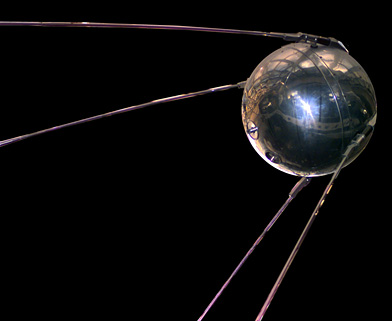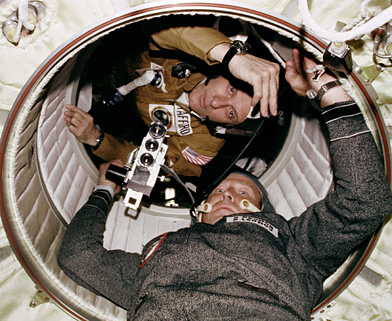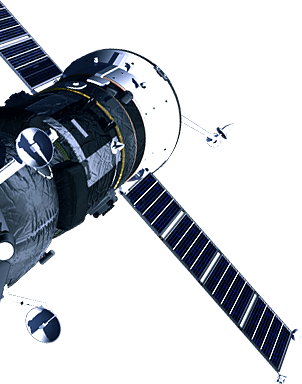
|

|
 Find out more about the project’s destination—the moon. An in-depth look at one of the most familiar celestial bodies is provided here. Find out more about the project’s destination—the moon. An in-depth look at one of the most familiar celestial bodies is provided here.
|
|


The Soviet Union continued to win the “first human” titles, with Yuri Gagarin becoming the first human to fly in space in April 1961, and Alexey Leonov achieving the first spacewalk outside a spaceship in March 1965. Aiming to reverse the situation, the United States decided to head for the Moon.
After overcoming many difficulties and failures, the United States finally succeeded in sending two American astronauts to the Moon with Apollo 11 in July 1969. It is said that around 500 million people all over the world watched their landing on the Moon on TV. This demonstrated to the world the victory of the United States. In 1972, the US Apollo spacecraft and the Soviet Union’s Soyuz spacecraft successfully docked with each other. The astronauts of the two countries hugged each other, marking the end of the Space Race that had lasted for 15 years.





In May 1961, a statement by President John F. Kennedy in his speech marked the beginning of the Apollo program of the United States.
“I believe that this nation should commit itself to achieving the goal, before this decade is out, of landing a man on the Moon and returning him safely to the Earth.”
At that time, however, the United States had not even sent a human being to space. The development for the mission was extremely difficult, and even led to the tragic deaths of three astronauts in a ground test of Apollo 1.
Under such circumstances, having overcome many challenges, two US astronauts landed in the Sea of Tranquility on the surface of the Moon on July 20, 1969, becoming the first humans to set foot on a celestial body other than the Earth. The commander Armstrong's words "That is one small step for (a) man, one giant leap for mankind" were engraved in human history.
After that, NASA continued to conduct activities on the Moon. The Apollo 15 carried a lunar rover, with which the astronauts conducted geological surveys over a wide area of the lunar surface, resulting in the discovery of Genesis Rock, a moon rock formed about 4 billion years ago.
The program faced several setbacks. In the Apollo 13 mission, the spacecraft travelling to the Moon developed trouble, putting the crew at terrible risk. However, the ground controller instructed the crew how to maintain electricity and remove carbon dioxide, and guided the three astronauts safely back to the Earth. This was praised as the miracle of Apollo 13.
The Apollo program landed a total of 12 American astronauts on the Moon and brought several great discoveries regarding how the Moon had emerged and evolved. However, as the public became less interested in Apollo, the program, which was initially planned to be continued up to Apollo 20, ended with the Apollo 17 mission in 1972. On the day that Apollo 17 departed from the Moon, the commander Eugene Cernan placed a commemorative plaque on the Moon, saying that it would remain there until someone visited there and read the plaque, thereby expanding the exploration and meanings of Apollo.



©JiJi Press Photo
While the Apollo program gained some important clues regarding how the Moon was formed, it also left new mysteries about the details of the genesis of the Moon and its geography, which is totally different on the front and back sides. In the 1990s, the United States, Japan and other countries began launching unmanned probes to solve these mysteries.
A US probe Clementine, for example, searched all over the Moon for resources and discovered that water (ice) may exist in layers at the lunar pole. To confirm the existence of water, the Lunar Prospector took over the mission and announced that there was approx. 6 billion tons of ice there.
In the 21st century, a full-fledged “Lunar Rush” began following the United States’ announcement of its new space policy in 2004, which pledged a return to the Moon. Among the countries that joined the rush, Japan was one of the first to launch a lunar probe, “Kaguya,” to conduct a full-scale scientific exploration.
Lunar explorations since 1990 have differed from those in the early days, in that not only the US, Russia and Japan but also China and India have embarked on lunar exploration. In particular, China places emphasis on its own independent lunar explorations and has made steady advancements: it consecutively launched satellites Chang’e 1 and Chang’e 2, and with Chang’e 3, it succeeded in maneuvering the Yutu lunar rover on the Moon. In the near future, China is likely to bring some stones from the Moon, and strive toward manned lunar landing.
India succeeded in its first lunar exploration in 2008 with Chandrayaan-1, and is currently spending approx. 90 million dollars in developing Chandrayaan-2. Not to be overtaken by these emerging countries, Japan, the United States and European countries have held discussions aimed at the Moon, asteroids and Mars, in turn generating new competition. As the race for lunar exploration is gathering pace due to the participation of emerging countries, it will not be long before human beings land on the Moon again.


“Today, some rich people have already taken trips to the International Space Station for a week, paying several billion yen. It may not even take 30 years for rich people to choose the Moon as a destination for their exotic trips.” What, then, will the environment on the Moon’s surface be like at that time?
Space development by human beings has witnessed many dramas. The next 30 years will also see many dramas, beyond which we will see a wonderful “world” of space that far exceeds our imagination.

Share this article





